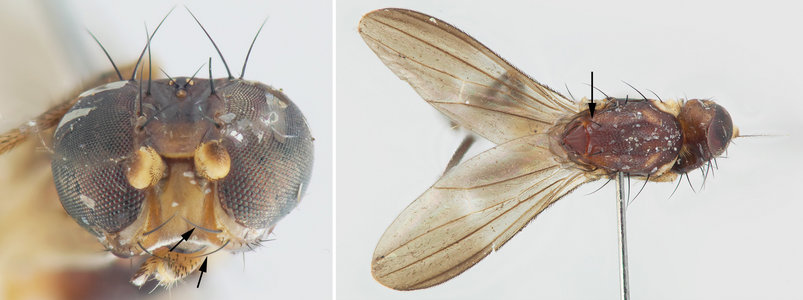Melanoclusia
Melanoclusia bivibrissa
Owen Lonsdale and Steve MarshallIntroduction
Melanoclusia Lonsdale & Marshall is represented by the single species M. bivibrissa Lonsdale & Marshall, which is known from only one male and one female from Borneo (Lonsdale & Marshall, 2008). While not observed in the field, the unusual colouration and chaetotaxy of this species suggests that behaviour plays an important role as a secondary sexual character – this has been documented in many other species of Clusiidae with similar morphology, including those in the behaviourally fascinating Heteromeringia Czerny, Clusiodes Coquillett and Hendelia Czerny. The discovery of this genus is significant in that it has important ramifications for understanding the evolutionary history and biogeography of the Clusiidae, both as a “missing link” in the subfamily Clusiinae and as the sister-group to the common Holarctic/Oriental genus Clusia Haliday.
Characteristics
Melanoclusia is unusual in appearance, differing from Clusia (the most closely related genus) and all other Clusiidae in having only one pair of dorsocentral bristles, no dorsal preapical tibial bristles, a vibrissa-like anterior genal bristle, a shiny frons with no interfrontal bristles, a rounded frons and face, a white vein dm-cu and dark colouration. The external male genitalia are similar to those of Clusia, but the internal components are unusual in that they are extremely elongate, projecting far into the abdomen.
Relationship of Melanoclusia bivibrissa to other Clusiidae
Reduced postverticals and male-specific characters support a relationship with Clusia, but Melanoclusia bivibrissa lacks all of the distinct external synapomorphies used to separate that genus from other Clusiidae (interfrontal bristles, pubescent arista and striped scutellum). It is for this reason that Melanoclusia bivibrissa is treated as the sister group to Clusia and not a highly derived basal species of that genus. The male characters supporting a relationship between Melanoclusia and Clusia include the following: two rows of posteroventral bristles on the fore and mid femora (also found in the Chilean Clusiidae and Clusiodes), an inner-basal spur on a small, triangular surstylus, a uniquely-shaped pregonite (long, thin, minutely setulose along length and closely-associated with base of phallapodeme) and absence of the lateral lobes of the distiphallus (independently lost in some Sobarocephalinae and most Clusiodinae).
References
Lonsdale, O. & Marshall, S.A. 2008. Synonymy within Clusia and description of the new genus Melanoclusia (Diptera: Clusiidae: Clusiinae). Annals of the Entomological Society of America 101(2): 327-330
Title Illustrations

| Scientific Name | Melanoclusia bivibrissa Lonsdale & Marshall |
|---|---|
| Location | Malaysia. Borneo |
| Specimen Condition | Dead Specimen |
| Identified By | O. Lonsdale |
| Sex | Male |
| Life Cycle Stage | Adult |
| Body Part | Head, dorsal (abdomen removed) |
| Collection | USNM |
| Type | Holotype |
| Image Use |
 This media file is licensed under the Creative Commons Attribution-NonCommercial License - Version 3.0. This media file is licensed under the Creative Commons Attribution-NonCommercial License - Version 3.0.
|
| Copyright |
© Owen Lonsdale

|
About This Page
Owen Lonsdale

Canadian National Collection of Insects, Arachnids & Nematodes
Steve Marshall

University of Guelph, Canada
Correspondence regarding this page should be directed to Owen Lonsdale at and Steve Marshall at
Page copyright © 2011 Owen Lonsdale and Steve Marshall
 Page: Tree of Life
Melanoclusia . Melanoclusia bivibrissa .
Authored by
Owen Lonsdale and Steve Marshall.
The TEXT of this page is licensed under the
Creative Commons Attribution-NonCommercial License - Version 3.0. Note that images and other media
featured on this page are each governed by their own license, and they may or may not be available
for reuse. Click on an image or a media link to access the media data window, which provides the
relevant licensing information. For the general terms and conditions of ToL material reuse and
redistribution, please see the Tree of Life Copyright
Policies.
Page: Tree of Life
Melanoclusia . Melanoclusia bivibrissa .
Authored by
Owen Lonsdale and Steve Marshall.
The TEXT of this page is licensed under the
Creative Commons Attribution-NonCommercial License - Version 3.0. Note that images and other media
featured on this page are each governed by their own license, and they may or may not be available
for reuse. Click on an image or a media link to access the media data window, which provides the
relevant licensing information. For the general terms and conditions of ToL material reuse and
redistribution, please see the Tree of Life Copyright
Policies.
- First online 03 June 2008
- Content changed 24 November 2009
Citing this page:
Lonsdale, Owen and Steve Marshall. 2009. Melanoclusia . Melanoclusia bivibrissa . Version 24 November 2009. http://tolweb.org/Melanoclusia_bivibrissa/67805/2009.11.24 in The Tree of Life Web Project, http://tolweb.org/









 Go to quick links
Go to quick search
Go to navigation for this section of the ToL site
Go to detailed links for the ToL site
Go to quick links
Go to quick search
Go to navigation for this section of the ToL site
Go to detailed links for the ToL site